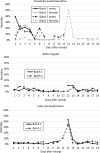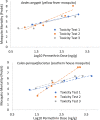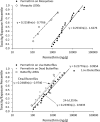Adult Mosquito and Butterfly Exposure to Permethrin and Relative Risk Following ULV Sprays from a Truck-Mounted Sprayer
- PMID: 38062179
- PMCID: PMC10830668
- DOI: 10.1007/s00244-023-01022-0
Adult Mosquito and Butterfly Exposure to Permethrin and Relative Risk Following ULV Sprays from a Truck-Mounted Sprayer
Abstract
Ground applications of adulticides via a specialized truck-mounted sprayer are one of the most common practices for control of flying adult mosquitoes. Aerosols released to drift through a targeted area persist in the air column to contact and kill flying mosquitoes, but may also drift into adjacent areas not targeted by the applications where it may affect nontarget insects such as imperiled butterflies. This study compared the risk of permethrin to adult mosquitoes and adult butterflies to assess the likelihood that the butterflies would be affected following such sprays. Permethrin toxicity values were determined for Aedes aegypti and Culex quinquefasciatus (LD50s of 81.1 and 166.3 ng/g dw, respectively) and then combined with published toxicity data in a species sensitivity distribution for comparison with published permethrin toxicity data for adult butterflies. The sensitivity distributions indicated adult butterflies and mosquitoes are similarly sensitive, meaning relative risk would be a function of exposure. Exposure of adult butterflies and adult mosquitoes to permethrin was measured following their exposure to ULV sprays in an open field. Average permethrin concentrations on adult mosquitoes (912-38,061 ng/g dw) were typically an order of magnitude greater than on adult butterflies (110-11,004 ng/g dw) following each spray, indicating lower risk for butterflies relative to mosquitoes. Despite lower estimated risk, 100% mortality of adult butterflies occurred following some of the sprays. Additional studies could help understand exposure and risk for butterflies in densely vegetated habitats typical near areas treated by ULV sprays.
© 2023. This is a U.S. Government work and not under copyright protection in the US; foreign copyright protection may apply.
Conflict of interest statement
The authors have no relevant financial or non-financial interests to disclose.
Figures






Similar articles
-
Permethrin Contamination of Sawgrass Marshes and Potential Risk for the Imperiled Klot's Skipper Butterfly (Euphyes pilatka klotsi).Environ Toxicol Chem. 2024 Feb;43(2):267-278. doi: 10.1002/etc.5783. Epub 2023 Dec 21. Environ Toxicol Chem. 2024. PMID: 37921583
-
A critical review of ultralow-volume aerosols of insecticide applied with vehicle-mounted generators for adult mosquito control.J Am Mosq Control Assoc. 1998 Sep;14(3):305-34. J Am Mosq Control Assoc. 1998. PMID: 9813829 Review.
-
Use of butterflies as nontarget insect test species and the acute toxicity and hazard of mosquito control insecticides.Environ Toxicol Chem. 2011 Apr;30(4):997-1005. doi: 10.1002/etc.462. Epub 2011 Feb 19. Environ Toxicol Chem. 2011. PMID: 21309017
-
Semi-field evaluation of the space spray efficacy of Fludora Co-Max EW against wild insecticide-resistant Aedes aegypti and Culex quinquefasciatus mosquito populations from Abidjan, Côte d'Ivoire.Parasit Vectors. 2023 Feb 2;16(1):47. doi: 10.1186/s13071-022-05572-5. Parasit Vectors. 2023. PMID: 36732832 Free PMC article.
-
A review of ultralow-volume aerial sprays of insecticide for mosquito control.J Am Mosq Control Assoc. 1996 Dec;12(4):601-18. J Am Mosq Control Assoc. 1996. PMID: 9046465 Review.
References
-
- Abbott WS. A method of computing the effectiveness of an insecticide. J Econ Entomol. 1925;18:265–267. doi: 10.1093/jee/18.2.265a. - DOI
MeSH terms
Substances
Supplementary concepts
LinkOut - more resources
Full Text Sources

